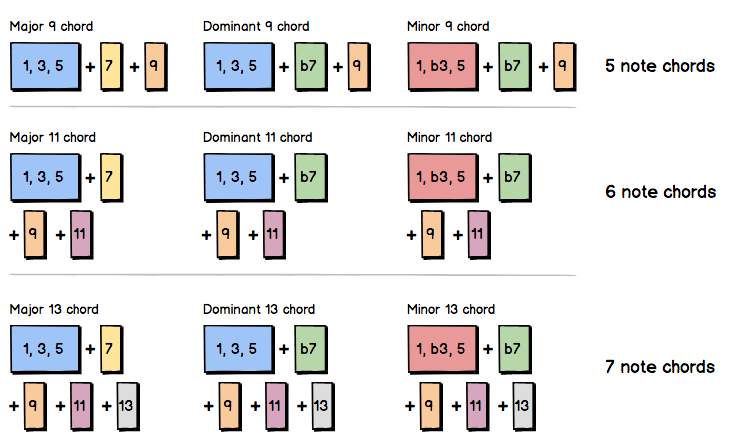Following the previous post on guitar chord construction this article discussed chord exensions. Extended chords are often avoided by the self taught guitar player firstly as the names of chord extensions can be a little intimidating but more significantly, many find it difficult to understand just when and where these extended chords can be applied.
Extended chords get a bad rap. Many guitar players think chord extensions are only for playing jazz. And, while its true that extended chords are prolific in the jazz genre, the colour that extended chords offer the guitarist shouldn’t be overlooked.
What’s your extension number?
Extended chords go by the numbers 9, 11 and 13. The higher the number, the more complex the chord. And by complex I mean the number of notes in the chord.
Chords are built by taking the odd numbered scale degrees and creating a “collection” of pitches. The most basic chords contain a collection of 3 of these scale degrees and the most complex contain 7.
1st level of complexity: 3 pitches (basic major, minor, augmented and diminished)
2nd level of complexity: 4 pitches (7th chords)
3rd level of complexity: 5 pitches (9th chords)
4th level of complexity: 6 pitches (11th chords)
5th level of complexity: 7 pitches (13th chords)
Level 2 is the common knowledge threshold for most guitarists
It’s first and second level chords (my label) that tend to be the most familiar to us. These two levels contain the Major, Minor, Augmented and Diminished chords (Level 1) and the the Level 2 chords: Major 7, Minor 7, Dominant 7, the Minor 7 flat 5 (half diminished) and the Minor Major 7 chords. These last 2 tend to be lesser known - the last only talked about in whispers!
Enter the 9th, 11th and 13th chords
At the 3rd level, the families of 9th chords are created and continue to follow the categories from the 4 note chords: major, minor, and dominant – thus yielding Major 9 (Maj9 or M9), Minor 9 (min9 or m9), and Dominant 9 (dom9 or mainly just called 9ths)
Running out of fingers and strings
On a piano it is possible to play all the notes of a complex chord like a 13th because piano players have the fingers of both hands available to play this 7 note chord. But on guitar you’ve only got 4 fingers to fret these chords. So after the 3rd level (9th chords) there are no more fingers or strings available to you. And, there is also another issue…
Urg! That sounds too dense
The sonic issue with complex chords is that the more pitches that are added, the muddier the chord begins to sound. This sonic density is not pleasing to the ear.
So how do you play 11th and 13th chords?
The answer is counter-intuitive and you might laugh because in seems weird after talking about adding notes to yield increasingly more complex extended chords.
The solution is to remove tones from the chord (ironic as you’ve just spent time adding them in). Yes, completely removing certain pitches from your extended chord facilitates: the following:
Easier to play (less fingers required)
Sounds less muddy (restores harmonic clarity)
If you’ve got guesses about exactly which notes are “removed” from extended chords, make them now.
Which pitches are omitted in chord extensions?
It’s all about relevance. Some notes in a chord are more relevant than others. Some add to the colour of a chord, others are just filler.
The 3rd for example is a vital determinant in the “gender” of the chord (natural 3 = major, b3 = minor) so that one gets to stay. But who gets voted off the island?
The 5th is the first one to go. Sonically the 5th bulks up and thickens the sound of a chord but doesn’t add any colour. You find the annotation (omit5) in many chord books, and leaving out the 5th is common as early as 4 note chords – both 7ths and 9ths.
The root is the next to be axed. WTF?
“This is heresy!” you cry.
“How can the note which detemines the chord name be left out in the cold?”
Simple. Somebody else plays it. It’s usually the bass player or perhaps the keyboard player, so don’t feel bad for them.
Extended chords played with jazz fingerings
Extended chord shapes are often called “jazz chords” or “jazz chord extensions”. This is a misnomer because but really they are just chord voicings independent of any genre.
The use of 9th, 11ths and 13ths (often called the Upper Extensions) is certain more prevalent in jazz and perhaps why these labels came about.




